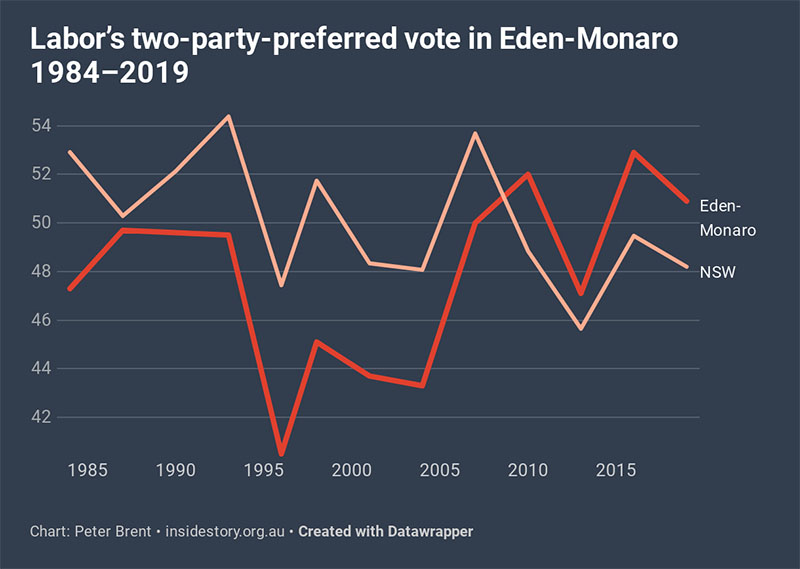Thursday’s by-election preview on these pages ended with these words:
I have no idea who will win Eden-Monaro, which is not the same thing as saying it’ll be close. As for the “we won’t know the result for days” trope, that’s always unlikely.
Well, the result was indeed close, and on Sunday morning we don’t have a clear winner. But it appears very likely to be Labor’s Kristy McBain, with a two-party-preferred vote of between 50.5 and 51 per cent — not very different from Mike Kelly’s at last year’s general election.
Assuming a McBain win, here are a few take-outs.
Personal votes do matter
Most importantly, the former mayor of Bega shire’s personal vote in the part of the electorate where she’s best known appears to have made a big difference. Did it make the difference? Probably.
On current counting, booths in what’s roughly a quarter of the seat put in a combined 4.3 per cent swing to Labor from the 2019 result. In the rest of the seat it was a 0.9 per cent swing to the Liberal candidate Fiona Kotvojs. As 0.9 per cent happens to be the swing required to win, we can say that had Bega shire swung the same way as the rest of Eden-Monaro, Kotvojs would now be MP-elect… probably.
(A more general role might have been played by the summer bushfires, and calculating swings in areas worst hit by fires, inside and outside Bega shire, would be a useful exercise.)
Ballot draws matter, too
Another likely necessary condition for the result is the ballot draw. McBain appeared eighth — nothing to write home about — but Kotvojs drew fourteenth, at the very bottom.
At last year’s general election, in the 139 Labor versus Liberal (or LNP or CLP) contests, Labor candidates listed ahead on the ballot averaged 51.7 per cent of the two-party-preferred vote. When the order was reversed, Labor’s vote averaged 47.1. That 4.6 per cent seems massive (the 2016 number was only a bit smaller, 52.3 versus 48.5, or 3.8 per cent). With McBain’s eventual margin probably less than 1 per cent, ballot position very likely made the difference.
Historically, drawing the last spot on the ballot has, on average, been worst of all. (I will devote an article to this whole topic at some stage.)
Mike Kelly was missed
In claiming underdog status before the count, Labor leader Anthony Albanese put retired MP Mike Kelly’s personal vote at around 3 per cent. I reckon that’s conservative, if anything, and it was more likely around 4 or 5, as this graph from an earlier piece suggests.

2022 will mostly be different
The next election, due in 2022, will be a fresh contest, and folks in Eden-Monaro will, as elsewhere, mainly vote for the side they want to see in power. By-elections are about just about everything except that. Saturday’s result makes a Labor victory next time in Eden-Monaro more likely, because winning a seat is easier with the benefits of incumbency, and a sophomore surge (outside the Bega shire at least), than without.
Albo’s enemies got some ammunition
The average by-election swing to oppositions in seats they held is 1.1 per cent, Labor didn’t achieve that, and Albanese’s internal enemies will no doubt wield such statistics against him.
But this result tells us nothing about the Labor leader’s electoral prowess. The absence of a big swing to the opposition does suggest there was no strong desire to “send a message” to Scott Morrison, but apart from that, there’s no point trying to discern anything about the current political landscape.
Which won’t stop players and commentators doing just that. •
Thanks to Ben Raue for identifying Bega Valley Shire booths.





